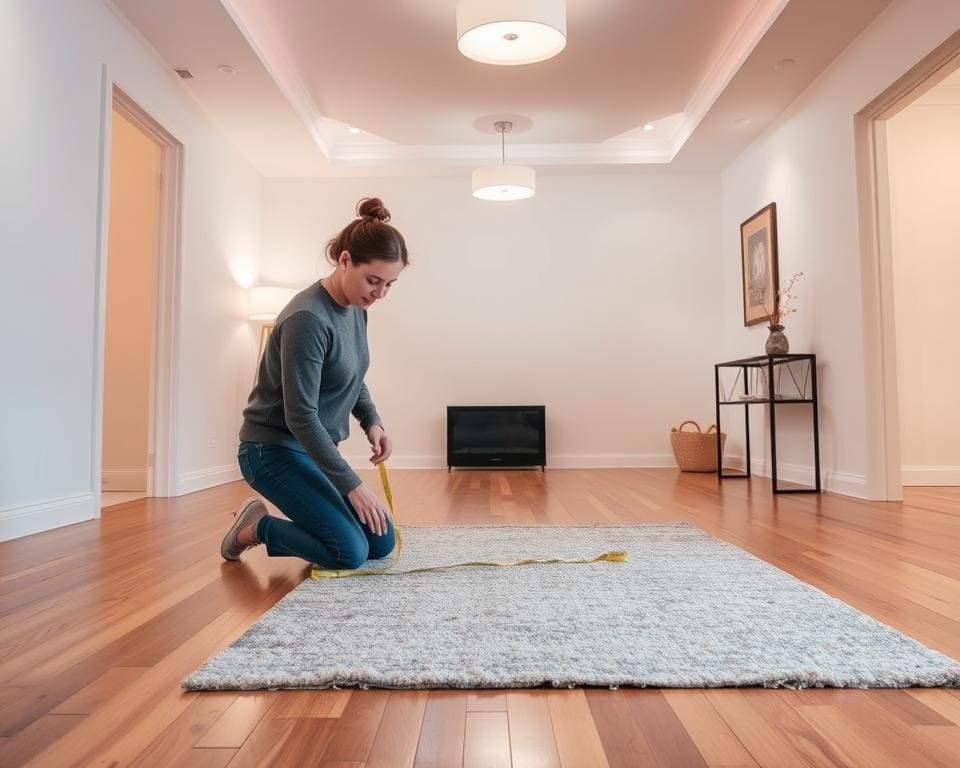When considering how do you choose the perfect rug size for your room, it’s essential to recognise the significance of harmony in interior design. Selecting the right rug size not only defines the space but also enhances the overall aesthetic, creating a sense of balance and warmth. As you navigate the realms of area rug sizing, keep in mind how the rug interacts with both the dimensions of the room and the arrangement of furniture. This vital piece of décor can truly elevate your living space when chosen thoughtfully, aligning with your style preferences and the latest design trends.
Understanding Room Dimensions and Layout
When considering the perfect rug size, a comprehensive understanding of room dimensions and layout can greatly influence your decision. Proper measurements and layout planning ensure the selected rug enhances the overall aesthetic of your space. This journey begins with accurate measurements of your room.
Measuring Your Space Correctly
Precise measurements are essential when measuring rug size. Utilising a measuring tape allows you to capture the dimensions of your room accurately. Start by measuring the length and width of the area where the rug will reside. Keep in mind the placement of furniture; it is often recommended that at least the front legs of your sofa or chairs sit on the rug. This arrangement creates a cohesive look within your room layout, uniting separate areas of the space.
Popular Room Layouts to Consider
Different room layouts can significantly impact your rug choice. Open floor plans are trending in modern interior design, where rugs can delineate living spaces while maintaining a fluid movement through the area. Conversely, traditional rooms may benefit from a larger area rug to anchor furniture and create a sense of intimacy. Understanding your style and how room dimensions interact will guide your final decision.

How do you choose the perfect rug size for your room?
Choosing the perfect rug size involves a keen understanding of the relationship between furniture and space. Identifying key furniture pieces serves as a foundational step in this process. Each item in a room, from sofas to coffee tables, contributes to the room’s overall harmony. An appropriately sized rug can not only complement these furnishings but also enhance the overall aesthetic appeal.
Identifying Key Furniture Pieces
Before selecting a rug, assess the main furniture within the room. Take note of the dimensions and arrangement of the key pieces. For instance, a large sofa creates a focal point and requires a rug that can anchor it effectively. When identifying key furniture pieces, aim for a rug that allows for ample space around the legs of the sofa and chairs, creating a sense of integration and comfort in the room. This balance is critical for achieving a harmonious design.
The Role of Rug Placement in Room Aesthetics
The placement of a rug significantly impacts the visual flow of the space. Strategic rug placement can transform the atmosphere, making a room feel more inviting and cohesive. Positioning the rug so that it sits beneath key furniture pieces allows it to unify the decor elements in the room. Aim to follow these room decor tips:
- Ensure at least the front legs of furniture sit on the rug for stability.
- Consider centring the rug under a coffee table to define the seating area.
- Leave some floor visible around the rug for a balanced look.
When done correctly, the right mix of rug size and placement not only defines spaces but also adds warmth and depth, contributing to the overall design narrative of the room.
Rug Size Guide: Finding the Right Fit
Choosing the right rug is essential for enhancing the overall aesthetic of a room. Understanding standard rug sizes can simplify this process, allowing for effortless coordination of decor and space. The challenge can arise when personal taste clashes with conventional dimensions. This is where a rug size guide becomes invaluable, especially when weighing the options of custom vs. standard rug sizing.
Standard Rug Sizes for Different Rooms
Standard rug sizes vary significantly between different rooms, each designed to serve specific purposes:
- Living Room: Common dimensions include 160 x 230 cm, 200 x 300 cm, and 250 x 350 cm. These sizes enhance seating areas and create a cohesive look.
- Dining Area: A typical size such as 200 x 300 cm or 250 x 350 cm is ideal to ensure chairs can be pulled out without catching on the edge.
- Bedroom: For a cosy feel, standard sizes of 160 x 230 cm or 200 x 300 cm work well under the bed or next to it.
Custom vs. Standard Rug Sizing
When standard rug sizes do not meet specific needs, custom vs. standard rug sizing becomes a critical consideration. Custom options allow for tailored dimensions that align with unconventional layouts or design aspirations. This bespoke approach ensures the rug complements unique architectural features or personal decor motives, providing that perfect fit.
Incorporating Rug Size into Your Interior Design
Rug size plays a crucial role in the overall aesthetic of your space, significantly influencing the feeling of harmony within your interior design. By selecting an appropriate size, you can effectively enhance the atmosphere and functionality of your rooms. Understanding the synergy between rugs and your existing decor allows you to create a visually appealing and cohesive environment.
Complementing Your Room Decor
To succeed in complementing your room decor, consider the colours, patterns, and textures of your furnishings. A well-chosen rug can tie together different elements, creating a balanced look. Pay attention to the following:
- Colour coordination: Choose a rug that either matches or complements the predominant colours in your furnishings.
- Pattern integration: Select a rug that features patterns that harmonise with other textile designs in the room.
- Texture balance: Introduce a rug with a texture that adds depth without overwhelming the existing decor.
Using Rugs to Define Spaces
Using rugs to define spaces can create a sense of separation in open-plan layouts, enhancing both functionality and style. This technique helps delineate areas for specific activities, such as:
- A reading nook: Position a plush rug beneath a chair and bookshelf to create a cosy, inviting reading spot.
- A dining area: Opt for a larger rug that encompasses the dining table and chairs, establishing a dedicated eating space.
- A conversation corner: Use a rug to anchor seating arrangements, making the area feel more intimate and inviting.
Tips for Selecting the Right Rug Size
When embarking on the journey of selecting the right rug size for your space, it’s crucial to consider how the rug interacts with your existing room decor. One effective technique is to use painter’s tape to outline the intended rug area on the floor. This strategy not only helps visualise the rug placement but also enables you to assess the balance and proportion within the room. Ensuring your rug complements your furnishings can enhance the overall aesthetic while providing comfort underfoot.
Moreover, keeping the scale of your furniture in mind is essential when navigating area rug sizing. A rug that’s too small can make a spacious room feel disjointed, while a larger rug can anchor the space and create a cohesive look. Consider placing front legs of larger furniture pieces, like sofas or chairs, on the rug to establish harmony. These room decor tips can be invaluable in guiding your decision-making process.
Finally, it’s important to remember that selecting the right rug size should reflect your personal style and functionality. Think creatively about how a rug can define spaces or unify décor elements. Whether you opt for a bold statement piece or a more subdued design, the rug should resonate with your unique tastes, ensuring it becomes a cherished part of your room for many years to come.









